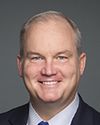Yes, I appreciate that.
You said that there are really two groups. There are those who have been exposed to DU through the lungs, through an air exposure, and there are the other veterans who have been exposed to DU who have embedded fragments in their bodies.
I guess what you've concluded is that even though veterans have had fragments of DU in their bodies—and correct me if I'm wrong—even with those fragments in their bodies, they have had no ill health effects attributed to DU. Is that correct?




